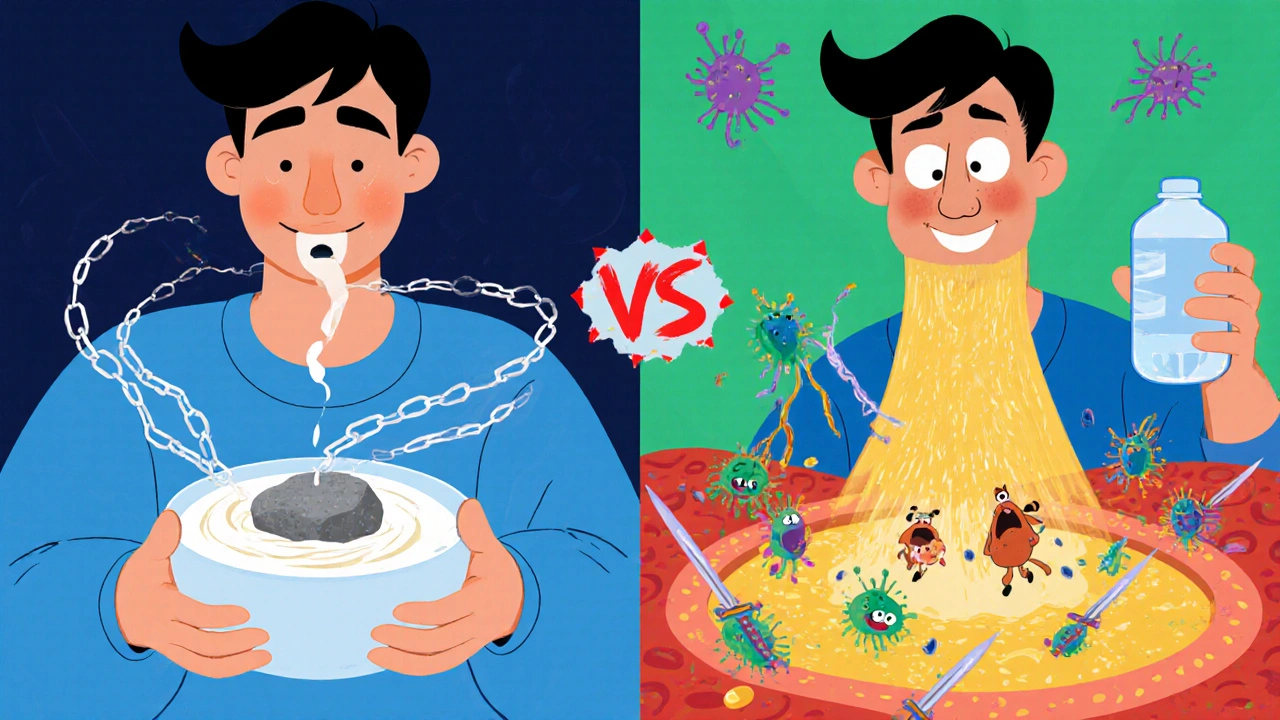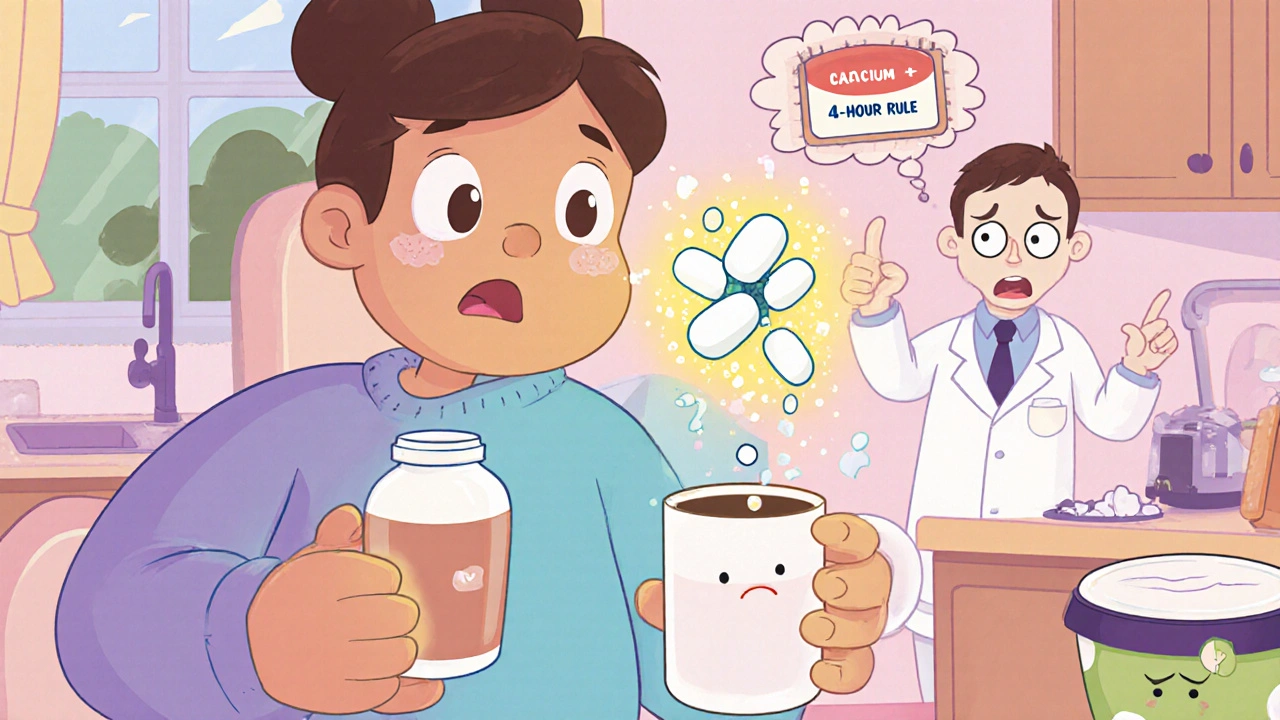It’s a simple morning routine: coffee with milk, toast with butter, maybe a cup of yogurt. But if you’re taking an antibiotic like doxycycline or ciprofloxacin, that routine could be sabotaging your treatment-without you even realizing it. The problem isn’t that dairy is bad for you. It’s that the calcium in milk, yogurt, and cheese binds to certain antibiotics in your stomach, turning them into a substance your body can’t absorb. And if the antibiotic doesn’t get into your bloodstream, it can’t kill the infection. This isn’t a myth or an old wives’ tale. It’s a well-documented, clinically significant interaction that affects millions of people every year.
Which Antibiotics Are Affected?
Not all antibiotics react the same way with dairy. The big ones to watch out for are tetracyclines and fluoroquinolones. Tetracycline, doxycycline, and minocycline fall into the tetracycline class. These were among the first antibiotics where this interaction was discovered back in the 1950s. Fluoroquinolones include ciprofloxacin, levofloxacin, and moxifloxacin. These are commonly prescribed for urinary tract infections, sinus infections, and even some types of pneumonia.Why these two classes? It comes down to their chemical structure. Tetracyclines have specific binding sites that latch onto calcium ions like a magnet. Fluoroquinolones work similarly, though the binding is a bit weaker. When calcium from dairy meets these antibiotics, they form large, insoluble complexes. Think of it like mixing baking soda and vinegar-it creates a new substance that doesn’t dissolve the same way. These complexes just pass through your gut and out of your body, useless.
Other antibiotics? Most beta-lactams like amoxicillin, penicillin, and cefalexin are mostly unaffected. Azithromycin and clarithromycin? Also fine with dairy. That’s important to know because if you’re on one of these, you don’t need to change your breakfast. But if you’re on doxycycline or ciprofloxacin, you’re playing with fire if you mix it with milk.
How Much Absorption Do You Lose?
The numbers are startling. Take doxycycline, one of the most commonly prescribed antibiotics. If you take it with a glass of milk, you might absorb only 50% of the dose. With yogurt? That number can drop to 30% or lower. For ciprofloxacin, studies show up to a 92% drop in absorption when taken with yogurt. That’s not a small reduction-it’s a near-total loss of effectiveness.What does that mean in real terms? If your doctor prescribes a 100 mg dose of doxycycline, and you take it with milk, you’re effectively getting only 30 to 50 mg into your bloodstream. That’s not enough to kill off the bacteria. Instead, you’re exposing them to a sub-lethal dose. And that’s how antibiotic resistance starts. Bacteria that survive the weak dose become stronger, harder to kill next time. The World Health Organization estimates over 1.2 million deaths each year are directly tied to antibiotic-resistant infections. Poor timing with dairy is one small, preventable piece of that crisis.
Timing Is Everything
So what should you do? The rule is simple: separate your antibiotic from dairy by at least 2 to 4 hours. For tetracyclines like doxycycline, aim for 4 hours before or after dairy. For fluoroquinolones like ciprofloxacin, 2 hours is usually enough. That means if you take your antibiotic at 7 a.m., you shouldn’t have milk in your coffee until 11 a.m. If you take it at night, don’t have a bowl of yogurt before bed.Why the difference? Tetracyclines bind to calcium so tightly that even small amounts can interfere. The body needs more time to clear the calcium before the antibiotic can be absorbed. Fluoroquinolones are a bit less picky, but still sensitive enough that skipping the timing can cut effectiveness in half.
It’s not just milk. All dairy counts: yogurt, cheese, ice cream, cottage cheese, butter, whipped cream, even whey protein shakes. And don’t forget hidden sources-some cereals are fortified with calcium, some orange juices have added calcium, and even certain antacids and mineral supplements contain calcium, magnesium, or iron-all of which cause the same problem.

What About Non-Dairy Alternatives?
A lot of people think almond milk, oat milk, or soy milk are safe. But here’s the catch: many of them are fortified with calcium. A single cup of fortified almond milk can have as much calcium as cow’s milk-sometimes more. If you’re taking doxycycline and you drink calcium-fortified almond milk with your cereal, you’re still blocking absorption. Always check the label. If it says “calcium added,” treat it like dairy.Plain, unfortified plant milks without added minerals are usually okay. But you can’t assume. Always read the nutrition facts. Look for “calcium” in the ingredient list or the % Daily Value. If it’s above 10% per serving, avoid it within the critical window.
Why Do People Keep Making This Mistake?
It’s not just ignorance. It’s convenience. Many antibiotics, especially tetracyclines, cause stomach upset when taken on an empty stomach. So people reach for milk or yogurt to ease the nausea. It makes sense-but it’s dangerous. One study found that nearly 30% of patients intentionally took dairy with their antibiotics just to avoid feeling sick. That’s a trade-off no one should make.Another problem? Confusion about timing. Patients think “don’t take it with food” means “don’t eat anything.” But the real issue isn’t food-it’s calcium. You can eat toast, fruit, eggs, or oatmeal without dairy just fine. You just need to avoid the milk, cheese, or yogurt in it.
And then there’s the issue of dosing schedules. If you’re supposed to take your antibiotic twice a day, and you eat dairy at every meal, finding two 4-hour windows becomes a logistical nightmare. That’s why some doctors now prescribe doxycycline monohydrate (brand name Oracea), which can be taken with food-including dairy-because it’s formulated differently. But not all versions have this feature. Always check your specific brand.

What Happens If You Mix Them?
If you accidentally take your antibiotic with dairy, don’t panic. One slip-up won’t ruin your entire course. But if it happens repeatedly, you’re at risk. The infection might not clear. Symptoms could linger. You might need a second round of antibiotics. Or worse-the bacteria could adapt and become resistant. That means next time you get sick, the same antibiotic might not work at all.And it’s not just about the antibiotic failing. Subtherapeutic levels mean the infection drags on longer. More doctor visits. More missed work. More risk of spreading the infection to others. In serious cases-like Rocky Mountain spotted fever treated with doxycycline-delayed or reduced absorption can be life-threatening.
How to Get It Right
Here’s a simple plan:- Check your prescription label. Does it say “take on an empty stomach” or “avoid dairy”? If yes, follow the timing rules.
- Take your antibiotic with a full glass of water-never with milk, juice, or coffee with cream.
- Wait at least 2 hours (for fluoroquinolones) or 4 hours (for tetracyclines) before eating or drinking anything with dairy or added calcium.
- Read labels on plant-based milks, cereals, and supplements. If calcium is added, avoid it during the window.
- If you’re unsure, ask your pharmacist. They can tell you exactly which products to avoid.
Some pharmacies now give out visual “timing wheels” at pickup-little cards that show you when to take your med and when dairy is safe. Ask for one. It’s a small tool that can prevent big problems.
What’s Changing in the Future?
Pharmaceutical companies are working on solutions. Newer antibiotics like sarecycline (Seysara) are designed to bind less to calcium. Some formulations already allow food intake without reducing effectiveness. But these are still exceptions. Most tetracyclines and fluoroquinolones on the market today still have the same problem.Research is also looking at genetics. Some people have variations in their intestinal transporters that make them more or less sensitive to calcium interference. In the future, we might see personalized dosing based on genetic profiles. But for now, the rule is universal: if your antibiotic is on the list, keep dairy at arm’s length.
The bottom line? Antibiotics are powerful tools. But they’re not magic. They need the right conditions to work. And sometimes, the thing that’s stopping them from working isn’t the bacteria-it’s your morning coffee with milk.
Can I drink coffee with milk while taking doxycycline?
No. Even a splash of milk in your coffee can interfere with doxycycline absorption. Wait at least 4 hours after taking your dose before having coffee with milk, cream, or any dairy product. Black coffee without dairy is fine.
Is yogurt better or worse than milk for antibiotic interactions?
Yogurt is worse. It has higher calcium concentration and lower pH than milk, which makes it bind even more tightly to antibiotics like doxycycline and ciprofloxacin. Studies show yogurt can reduce absorption by up to 92%, compared to about 70% with milk.
Can I take antibiotics with almond milk?
Only if it’s plain, unfortified almond milk without added calcium. Most store-bought almond milk is fortified with calcium-sometimes more than cow’s milk. Always check the label. If it says “calcium added,” avoid it within 2 to 4 hours of your antibiotic.
What if I forget and take my antibiotic with dairy?
Take your next dose on time, but without dairy. One mistake won’t ruin your treatment, but repeating it will. If you’re concerned, call your doctor or pharmacist. Don’t double up on your dose to make up for it-that can cause side effects.
Do all antibiotics interact with dairy?
No. Antibiotics like amoxicillin, azithromycin, and most cephalosporins can be taken with dairy without affecting absorption. But tetracyclines (doxycycline, tetracycline) and fluoroquinolones (ciprofloxacin, levofloxacin) definitely do. Always check the label or ask your pharmacist.
Why do some labels say “take on an empty stomach”?
Because food-especially dairy, calcium, iron, or magnesium-can block absorption. “Empty stomach” doesn’t mean you can’t eat anything. It means avoid dairy, antacids, calcium supplements, and iron pills for 2 to 4 hours before and after your dose. Plain foods like toast, fruit, or eggs are usually fine.
If you’re on an antibiotic that interacts with dairy, the key isn’t perfection-it’s awareness. You don’t have to give up dairy forever. You just need to time it right. That small change can mean the difference between a quick recovery and a lingering, resistant infection.


Sherri Naslund
November 20, 2025 AT 10:26Ashley Miller
November 22, 2025 AT 00:37Martin Rodrigue
November 23, 2025 AT 19:47rachna jafri
November 24, 2025 AT 19:43darnell hunter
November 25, 2025 AT 01:15Hannah Machiorlete
November 26, 2025 AT 21:20Bette Rivas
November 27, 2025 AT 09:54prasad gali
November 29, 2025 AT 01:50Paige Basford
November 29, 2025 AT 16:09Ankita Sinha
December 1, 2025 AT 08:55Kenneth Meyer
December 3, 2025 AT 01:13Donald Sanchez
December 3, 2025 AT 10:29Abdula'aziz Muhammad Nasir
December 4, 2025 AT 22:42Danielle Mazur
December 5, 2025 AT 18:30Margaret Wilson
December 5, 2025 AT 23:46